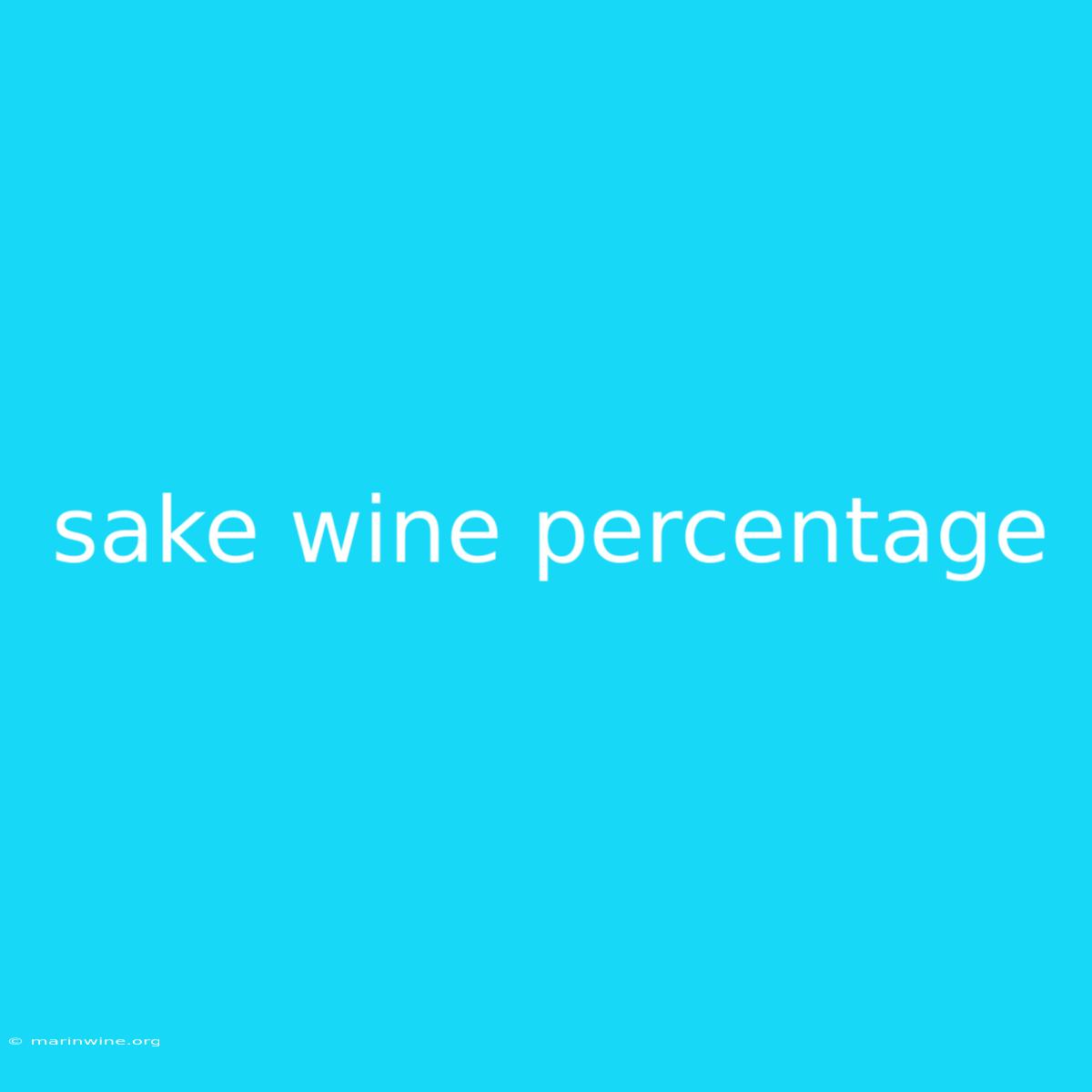Uncorking the Truth: What's the Sake Wine Percentage?
Have you ever wondered what percentage of alcohol is in sake? It's a common question, and the answer is not always straightforward! Sake, the beloved Japanese rice wine, has a surprisingly wide range of alcohol content, making it a versatile beverage for various palates and occasions.
Why This Matters: Understanding the alcohol content of sake is essential for making informed choices about your consumption. Whether you're enjoying it with a meal, celebrating a special occasion, or simply seeking a relaxing drink, knowing the strength can help you make responsible decisions.
Key Takeaways of Sake Wine Percentage:
| Category | Alcohol Content | Description |
|---|---|---|
| Junmai | 15% - 16% | A pure sake with no added alcohol, offering a complex and balanced flavor. |
| Junmai Ginjo | 14% - 16% | A premium sake made with high-quality rice, resulting in a delicate aroma. |
| Junmai Daiginjo | 14% - 17% | The most premium sake category, known for its refined and elegant flavors. |
| Honjozo | 14% - 17% | A sake with added alcohol for a slightly stronger and bolder flavor. |
| Ginjo | 14% - 17% | Similar to Junmai Ginjo, but with added alcohol, offering a smoother taste. |
| Daiginjo | 14% - 17% | Similar to Junmai Daiginjo, but with added alcohol for a more intense flavor. |
Sake Wine Percentage: A Deeper Dive
Sake Alcohol Content: Sake's alcohol content is determined by various factors, including the rice type, the brewing process, and the addition of alcohol. This results in a spectrum of alcohol levels across different sake styles.
Junmai Sake: Junmai sake, considered the purest form, uses only rice, water, koji (rice mold), and yeast during fermentation. It often boasts a slightly higher alcohol content compared to other categories, ranging from 15% to 16% ABV (alcohol by volume). This higher alcohol content stems from the rice's natural sugars being fully converted during fermentation.
Honjozo and Ginjo Sake: Honjozo and Ginjo sake, while using similar rice and yeast, incorporate a small percentage of distilled alcohol during the brewing process. This addition allows for a smoother, more refined taste and a slightly higher alcohol percentage, typically around 14% to 17%.
The Daiginjo Category: Daiginjo sake, known for its luxurious and delicate flavors, is produced with highly polished rice, resulting in a subtle yet complex aroma. This meticulous production process often leads to a higher alcohol content, ranging from 14% to 17% ABV.
Understanding the Impact of Alcohol Content
- Flavor Profile: A higher alcohol content often leads to a bolder and more intense flavor profile, while lower ABV sake offers a more delicate and nuanced taste.
- Pairing: The alcohol content can impact how well sake pairs with specific dishes. Higher ABV sake might better complement richer or more robust flavors, while lower ABV sake works well with delicate and light cuisine.
- Enjoyment: Individual preferences play a significant role in determining the ideal alcohol content for personal enjoyment. Some individuals prefer a stronger sake, while others appreciate a more delicate and subtle taste.
FAQ on Sake Wine Percentage:
Q: Is sake stronger than wine?
A: While sake can have a higher alcohol content than some wines, the average ABV of sake (15% - 16%) is often comparable to other alcoholic beverages like wine.
Q: Is sake stronger than beer?
A: Sake typically has a higher alcohol content than beer, which usually ranges between 4% and 6% ABV.
Q: Can I mix sake with other drinks?
A: While some people mix sake with other drinks, it's important to be mindful of the resulting alcohol content and its effects.
Q: Does sake cause a hangover?
A: Like any alcoholic beverage, excessive consumption of sake can lead to a hangover. It's essential to drink responsibly and in moderation.
Q: What is the best sake for beginners?
A: Junmai sake is a great option for beginners, offering a balanced flavor profile and a less intense alcohol content.
Tips for Enjoying Sake Wine:
- Choose the Right Sake: Consider the occasion, your personal preferences, and the dish you are pairing it with when selecting a sake.
- Serve at the Right Temperature: Sake is typically served chilled, but some styles are enjoyed warm.
- Use the Correct Glassware: Traditional sake cups or glasses are designed to enhance the aroma and flavor of sake.
- Pair it with Delicious Dishes: Sake complements a wide range of foods, from sushi and sashimi to grilled meats and vegetables.
- Savor the Experience: Appreciate the delicate flavors and subtle nuances of each sake.
Summary of Sake Wine Percentage:
Sake's alcohol content varies depending on the specific style and brewing process. Junmai sake, the purest form, tends to have a higher ABV, while Honjozo and Ginjo sake add distilled alcohol for a smoother taste. The Daiginjo category, renowned for its high-quality rice, often has a slightly higher alcohol content, resulting in a more intense flavor profile.
Closing Message:
Understanding sake's alcohol content unlocks a deeper appreciation for this complex and diverse beverage. By considering the different styles, flavor profiles, and pairing possibilities, you can navigate the world of sake with confidence and find your perfect match. Cheers to discovering new flavors and enjoying this unique Japanese treasure!

